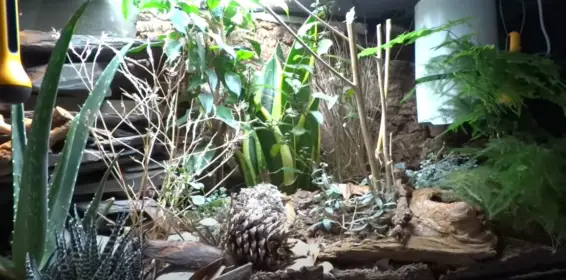Looking to create a thriving habitat for your leopard gecko? Want to provide them with an environment that promotes their natural behaviors and overall well-being? Look no further! In this article, we will show you exactly how to make a bioactive terrarium for your leopard gecko.
With this setup, you can create a miniature ecosystem that not only mimics their native habitat but also helps to maintain a clean and balanced living space for your reptile friend. So, let’s dive in and explore how to make a bioactive terrarium for leopard gecko, step by step. Let’s get started!
How to Make a Bioactive Terrarium for Leopard Gecko
Leopard geckos are fascinating reptiles that make great pets. To ensure their well-being and happiness, it’s important to provide them with a suitable habitat.
One popular and effective option is to create a bioactive terrarium. In this guide, we will walk you through the process of setting up a bioactive terrarium for your leopard gecko, step by step.
Benefits of a Bioactive Terrarium
Before we dive into the detailed steps, let’s take a moment to understand the benefits of a bioactive terrarium for your leopard gecko. Unlike traditional setups, bioactive terrariums aim to replicate a natural environment and promote a self-sustaining ecosystem within the enclosure.
Here are some of the advantages:
- Naturalistic Environment:
A bioactive terrarium provides a more natural and stimulating environment for your leopard gecko, mimicking their wild habitat.
- Improved Mental and Physical Health:
The natural elements and enrichment of a bioactive setup can result in better mental stimulation and physical exercise for your leopard gecko.
- Odor Control:
The live plants, microfauna, and natural processes in a bioactive terrarium help control and reduce odors compared to traditional setups.
- Reduced Cleaning Effort
With a self-sustaining bioactive ecosystem, you’ll spend less time cleaning the enclosure as the natural processes help maintain a cleaner habitat.
- Better Digestion and Health
The presence of microfauna, such as springtails and isopods, helps break down waste and maintain a healthy environment for your leopard gecko.
Now that we understand the benefits, let’s get started on creating a bioactive terrarium for your leopard gecko!
Step 1: Selecting the Right Enclosure
Choosing the right enclosure is crucial to create a suitable bioactive terrarium for your leopard gecko. Consider the following factors when selecting the enclosure:
- Size:
Leopard geckos need enough space to thrive, so choose an enclosure that provides ample room for them to move around and explore. A 20-gallon tank is usually a good starting point, but larger tanks are always better.
- Ventilation:
Ensure the enclosure has proper ventilation to maintain fresh air and prevent humidity buildup.
- Escape-Proof:
Choose an enclosure with secure locking mechanisms to prevent your leopard gecko from escaping.
Step 2: Substrate Selection
The substrate is an essential component of a bioactive terrarium as it not only provides a natural aesthetic but also supports the growth of beneficial microorganisms. Here are some suitable substrate options:
- Organic Topsoil:
Look for organic topsoil without any added chemicals or fertilizers. This will serve as the base layer for the terrarium.
- Coconut Fiber:
Mix in coconut fiber or coir to improve drainage and moisture retention.
- Leaf Litter:
Add a layer of dried leaves, such as oak or magnolia, to simulate the forest floor and provide hiding spots for your leopard gecko.
Step 3: Creating the Bioactive Ecosystem
Now it’s time to introduce the living components that make the terrarium bioactive. These components work together to create a self-sustaining ecosystem. Here’s what you’ll need:
- Live Plants:
Choose hardy and non-toxic plants that can thrive in the leopard gecko’s habitat. Some suitable options include snake plants, pothos, spider plants, and succulents. Ensure the plants are securely potted and have adequate lighting.
- Microfauna:
Introduce beneficial microfauna such as springtails and isopods. These tiny organisms help break down waste, control mold and fungus, and maintain a healthy soil ecosystem.
- Decomposition Zone:
Create a designated area in the bioactive terrarium to allow for the breakdown of organic waste. This can be achieved by providing a hidden area with an excess of leaf litter where the microfauna can thrive.
Read More: About How To Keep Floating Plants Away From Filter
Step 4: Temperature and Lighting
Maintaining the right temperature and lighting is essential for the health and well-being of your leopard gecko. Here are some key considerations:
- Temperature:
Provide a temperature gradient in the enclosure with a warm side (around 88-90°F) and a cool side (around 75-80°F). This allows your leopard gecko to regulate its body temperature as needed.
- Heat Source:
Install a heat mat or ceramic heat emitter on one side of the enclosure to create a warm basking spot for your leopard gecko.
- Lighting:
Use a full-spectrum UVB light to mimic natural sunlight. This helps with calcium absorption and overall health. Ensure there are areas in the enclosure where your leopard gecko can retreat from direct light if desired.
Step 5: Providing Hiding Spots and Enrichment
Leopard geckos are nocturnal and require hiding spots to feel secure. Here are some ideas for creating hiding spots and enrichment:
- Caves and Shelters:
Place a variety of hide boxes, cork bark, and branches in the terrarium to provide hiding spots for your leopard gecko.
- Climbing Opportunities:
Add branches and other vertical elements to encourage climbing and exercise.
- Feeding Enrichment:
Use feeding dishes or scatter feed to stimulate natural foraging behavior.
Step 6: Maintaining the Bioactive Terrarium
To ensure the long-term success of your bioactive terrarium, regular maintenance is essential. Here are some maintenance tasks to keep in mind:
- Monitor and Adjust:
Regularly check temperature, humidity, and lighting levels to ensure they remain within the optimal range for your leopard gecko.
- Spot Cleaning:
Remove any waste or uneaten food promptly to maintain cleanliness and prevent odors.
- Misting and Watering:
Depending on the humidity requirements of your leopard gecko, mist or water the terrarium as needed.
- Trim and Prune:
Trim and prune the live plants when necessary to maintain a healthy and aesthetically pleasing environment.
- Replace Substrate:
Periodically replace the top layer of substrate to refresh the terrarium and promote the growth of beneficial microorganisms.
With these steps, you can create a bioactive terrarium that provides a thriving and stimulating habitat for your leopard gecko. Enjoy observing your gecko in its naturalistic home and cherish the rewards of a bioactive setup.
Remember to monitor and adjust the terrarium’s conditions regularly to ensure your gecko’s health and happiness.
Frequently Asked Questions (FAQs)
A bioactive terrarium mimics the natural environment and allows for a self-cleaning system. The key is to use a natural substrate mixed with sphagnum moss and leaf litter. Add clean-up crew insects like isopods and springtails to help break down waste. Include live plants to absorb nutrients. Design proper heating and lighting that replicates their native desert habitat. Provide ample hides, rocks, branches, and other decor for enrichment. Allow the tank to establish for 1-2 months before adding your leopard gecko.
A suitable sized glass or plastic terrarium with a secure screen top
A natural substrate mix (soil, sand, excavator clay)
Sphagnum moss, leaf litter, bark
Live plants and seeds
Decor like rocks, wood, hides
Heat pad, ceramic heat emitter, UVB lighting
Clean-up crew insects (isopods, springtails)
A mix of 60-70% organic topsoil or coconut fiber and 30-40% play sand or excavator clay works well. Avoid calci-sand or other loose particle substrates.
Provide overhead heating with a ceramic heat emitter. Use a low wattage bulb to create a warm spot of 90-95 F on one side. Keep the cool side 75-80 F. Use linear UVB lighting spanning 3/4 of the tank. Turn off all lights at night to mimic natural cycles.
Good options include pothos, aloe vera, hen and chicks, snake plant, ficus, and air plants. Avoid plants with thick leaves or those toxic to reptiles.
Leopard geckos thrive in drier conditions of 20-40% humidity. Use a hygrometer to monitor levels. Increase ventilation or use a dehumidifier if needed. Mist sparingly if humidity gets too low.
Spot clean waste as needed but avoid completely changing the substrate for several months. Clean the glass as needed but limit disruption to plants and clean-up crew. Every 3-6 months replace a portion of the substrate.
Yes, you can place live insects like crickets or mealworms right into the tank. The leopard gecko will enjoy hunting for its food! Just be sure to remove any uneaten insects.
Read More: About Gardening In An Apartment Without A Balcony
Final Thoughts
Creating a bioactive terrarium for your leopard gecko is a great way to provide a natural and enriching environment for your pet. By incorporating live plants, beneficial insects, and a balanced ecosystem, you can mimic the gecko’s natural habitat while also reducing the need for constant cleaning and maintenance. To make a bioactive terrarium for your leopard gecko, start by selecting the appropriate terrarium size and materials.
Use a substrate made of coconut coir and organic soil, and include plants like pothos, spider plants, and succulents. Add clean-up crew insects like springtails and isopods to help break down waste. Regularly monitor and maintain the terrarium to ensure your leopard gecko’s health and happiness. By following these steps, you can create a bioactive terrarium that will provide a stimulating and natural environment for your leopard gecko.
Auto Amazon Links: No products found.
Perfect Plants Christmas Tree Saver 8oz. | Easy Use Xmas Tree Preserver Food | Have Healthy Green Christmas Trees All Holiday Season
$7.99 (as of December 23, 2025 06:28 GMT +00:00 - More info- Product prices and availability are accurate as of the date/time indicated and are subject to change. Any price and availability information displayed on [relevant Amazon Site(s), as applicable] at the time of purchase will apply to the purchase of this product.
FirEver Pure Christmas Tree Food | Preserver Additive & Season Extender for Live Xmas Trees | Keep It Green, Reduce Needle-Drop | Miracle Freshness (8 oz)
$9.16 (as of December 23, 2025 06:28 GMT +00:00 - More info- Product prices and availability are accurate as of the date/time indicated and are subject to change. Any price and availability information displayed on [relevant Amazon Site(s), as applicable] at the time of purchase will apply to the purchase of this product.
Wilt-Pruf® Christmas Tree/Cutting Preserver Spray |Preserves Christmas Trees, Wreaths, Garlands, Cuttings and Carved Pumpkins | Reduces Needle Drop | Keeps Cut Trees Fresh Longer | Natural (32 oz)
$21.99 (as of December 23, 2025 06:28 GMT +00:00 - More info- Product prices and availability are accurate as of the date/time indicated and are subject to change. Any price and availability information displayed on [relevant Amazon Site(s), as applicable] at the time of purchase will apply to the purchase of this product.
Transmission Funnel - 3'' Wide 23'' Long Funnel with Hose – Flexible, Reusable, No Leak Design Featuring Elastic Long Hose | Long Funnel for Oil, Gas, Coolant, Automotive and Garage Applications
$7.95 (as of December 23, 2025 06:28 GMT +00:00 - More info- Product prices and availability are accurate as of the date/time indicated and are subject to change. Any price and availability information displayed on [relevant Amazon Site(s), as applicable] at the time of purchase will apply to the purchase of this product.
TreeVive™ Natural Christmas Tree Preservative – Extends Freshness & Needle Retention – Enhances Pine Scent – Safe, Non-Toxic, Pet-Friendly Additive for Hydration, Color & Holiday Tree Care
$8.99 (as of December 23, 2025 06:28 GMT +00:00 - More info- Product prices and availability are accurate as of the date/time indicated and are subject to change. Any price and availability information displayed on [relevant Amazon Site(s), as applicable] at the time of purchase will apply to the purchase of this product.
Muddy Mat® | Super Absorbent Door Mat Indoor, Microfiber Quick Dry Chenille Entryway Rug, Non-Slip Front Door Mat, Indoor Mats for Entryway, Machine Washable Pet Rug, Grey 30"x19"
$19.95 (as of December 23, 2025 12:07 GMT +00:00 - More info- Product prices and availability are accurate as of the date/time indicated and are subject to change. Any price and availability information displayed on [relevant Amazon Site(s), as applicable] at the time of purchase will apply to the purchase of this product.
OLANLY Dog Door Mat for Muddy Paws 30x20, Absorbs Moisture and Dirt, Absorbent Non-Slip Washable Doormat, Quick Dry Chenille Mud Mat for Dogs, Entry Indoor Entryway Carpet for Inside Floor, Grey
$9.99 (as of December 23, 2025 12:07 GMT +00:00 - More info- Product prices and availability are accurate as of the date/time indicated and are subject to change. Any price and availability information displayed on [relevant Amazon Site(s), as applicable] at the time of purchase will apply to the purchase of this product.
Zevo Flying Insect Trap Official Refill Cartridges - Fits Both Zevo Trap & MAX Indoor Fly Trap - Authentic Trap+Lock Technology to Catch Gnats, House & Fruit Flys (4 Official Refill Cartridges)
$14.97 (as of December 23, 2025 12:07 GMT +00:00 - More info- Product prices and availability are accurate as of the date/time indicated and are subject to change. Any price and availability information displayed on [relevant Amazon Site(s), as applicable] at the time of purchase will apply to the purchase of this product.
TERRO Ant Killer Bait Stations T300B - Liquid Bait to Eliminate Ants - Bait System - 12 Count Stations for Effective Indoor Ant Control
$10.88 (as of December 23, 2025 12:07 GMT +00:00 - More info- Product prices and availability are accurate as of the date/time indicated and are subject to change. Any price and availability information displayed on [relevant Amazon Site(s), as applicable] at the time of purchase will apply to the purchase of this product.
ThermoPro TP50 Digital Hygrometer Indoor Thermometer Room Thermometer and Humidity Gauge with Temperature Humidity Monitor
$11.99 (as of December 23, 2025 12:07 GMT +00:00 - More info- Product prices and availability are accurate as of the date/time indicated and are subject to change. Any price and availability information displayed on [relevant Amazon Site(s), as applicable] at the time of purchase will apply to the purchase of this product.











